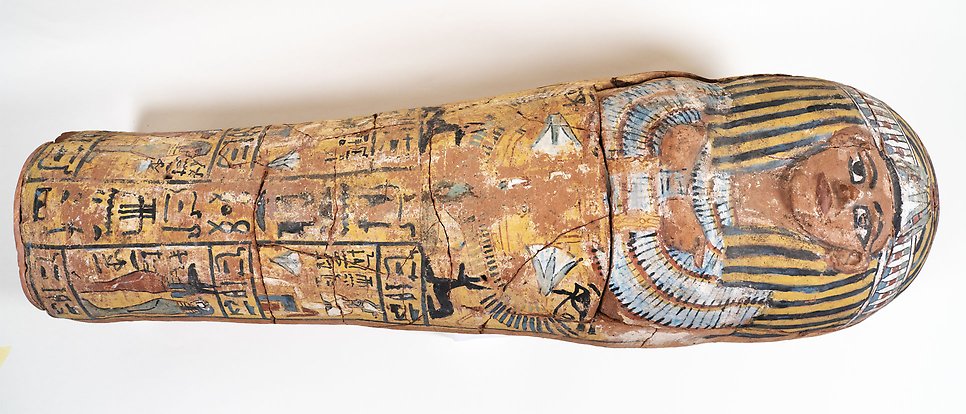Child sarcophagus returned to Gustavianum

The sarcophagus recently returned to Gustavianum is empty, made of ceramic and belonged to a boy. Photo: Marcus Holmqvist
A 3,200-year-old mummy sarcophagus has returned to Gustavianum – Uppsala University Museum, after disappearing from the collections for several decades. It is believed to have been sold to Boston in the United States using false papers in the mid-1980s. The sarcophagus belonged to a boy named Pa-nefer-neb.
The beautifully hand-painted ceramic sarcophagus has just been returned to Gustavianum from the Museum of Fine Arts in Boston. But how did such a valuable artefact from Uppsala University’s collections end up in Boston? Yes, it is somewhat of a mystery.
“It came to Uppsala University in 1922 but has been missing from the collections since at least the 1970s,” says Ludmila Werkström, curator of Gustavianum’s historical collections.
See the film in which Ludmila Werkström demonstrates the sarcophagus:
The child sarcophagus was originally found in Egypt in 1920 during an archaeological excavation led by British Egyptologist Flinders Petrie. The find was documented by a photograph taken on site. The sarcophagus was then sent to Uppsala when the finds were divided up – a system used at the time to allocate ownership of archaeological finds.
The Gustavianum archives contain documents proving that the sarcophagus was acquired by the Victoria Museum at Uppsala University in 1922. The object is also documented in the museum’s catalogue from the 1950s. What happened next is unclear.
Sold using forged documents
In 1985, the same sarcophagus was purchased by the Museum of Fine Arts in Boston. It was sold by an agent claiming to represent the Swedish artist Eric Ståhl (1918–1999). We now know that the documents accompanying the purchase were forged. For example, there was a letter allegedly written by Ståhl describing how he excavated the sarcophagus in Egypt in 1937. For several years, the Museum of Fine Arts presented the object online and in printed catalogues together with this origin story.
However, archive staff in Boston began to suspect that something was not right. For example, they discovered that the letter accompanying the purchase did not match the photograph from the excavation. They contacted Gustavianum and the two museums came to the same conclusion: the sarcophagus had been taken from Uppsala University’s collection without authorisation and should be returned.
“It is very gratifying that this return has now come to pass. The sarcophagus is an excellent complement to our Egyptian collections and will now be available for research. It needs some restoration, however, and it will be some time before it can be shown to the public in Gustavianum,” says Mikael Ahlund, Museum Director of Gustavianum, or Uppsala University Museum.
History of the sarcophagus
The sarcophagus was unearthed in Gurob, Egypt in 1920 during an archaeological excavation led by British Egyptologist Flinders Petrie. A photograph of the discovery on site during the excavation was published in Unseen Images: Archive Photographs in the Petrie Museum (2008), where it was also noted that the sarcophagus was sent to Uppsala when the finds were divided up, a system that allocated ownership of archaeological finds. The Gustavianum archives also contain documents confirming that the Victoria Museum of Egyptian Antiquities at Uppsala University, as the collection was then called, acquired the sarcophagus in 1922. It is also documented in the museum’s catalogue from the 1950s, but has been missing from the museum since at least the 1970s.
The mummy sarcophagus is made of ceramic, has been dated to the 19th dynasty (1295–1186 BC) and belonged to a boy named Pa-nefer-neb.
